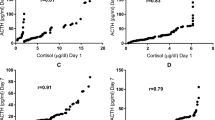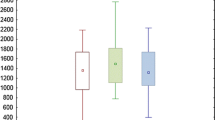Summary
Maternal and cord plasma cortisol concentrations have been measured after vaginal deliveries (spontaneous and forceps) or Caesarean sections. The plasma samples were analyzed by a competitive protein binding assay before and after fractionation using Sephadex LH-20 columnchromatography. The method is described in detail.
With the application of chromatography the results for the cortisol concentrations were in the maternal plasma approx. 30% and in the cord plasma approx. 70% lower than those obtained without previous plasma purification. Chromatography is thought to eliminate certain compounds from maternal and cord plasma which compete with cortisol for the binding sites on the cortisol binding globulin. Its application seems an essential methodological step in cortisol measurements.
The maternal cortisol concentration is after a vaginal delivery twice as high as the prelabour values, whereas a Caesarean section is accompanied only by a moderate rise in the plasma cortisol.
The cortisol level in the newborn delivered vaginally is twice to threetimes as high as that after a Caesarean section. The highest values are found in the forceps group.
There is no direct correlation between the maternal and cord plasma cortisol concentrations. On the contrary it seems that the newborn is able to increase its own plasma cortisol concentration independently, e.g. in response to the stress caused by the delivery. The absence of such a stress, as in the case of a Caesarean section, results in low cord plasma cortisol levels, a fact that could be hazardous for the newborn.
Zusammenfassung
Die Plasma-Kortisol-Konzentrationen wurden im mütterlichen und Nabelschnurblut nach vaginalen Entbindungen (spontan und Forceps), sowie nach Sectio caesarea gemessen. Als Bestimmungsmethode diente ein „competitive protein binding assay“ mit oder ohne vorgängiger Plasmafraktionierung durch Sephadex LH-20 Säulenchromatographie. Einzelheiten der Methode werden beschrieben.
Wenn die Säulenchromatographie in die Messmethode einbezogen wurde lagen die Ergebnisse der Kortisolbestimmungen für das mütterliche Plasma ca. 30% und für das Nabelschnurplasma ca. 70% niedriger verglichen mit den Resultaten eines einfachen „CPBA“. Man nimmt an, daß durch die Chromatographie gewisse Substanzen aus dem Plasma entfernt werden, welche in der Lage wären Kortisol kompetitiv von den Bindungsstellen am „cortisol binding globulin“ zu verdrängen. Der Einbezug der Plasmafraktionierung in die Bestimmungsmethode für Kortisol scheint demnach unerläßlich zu sein.
Nach einer vaginalen Geburt ist die Kortisol Konzentration im mütterlichen Plasma etwa doppelt so hoch wie vor Beginn der Wehentätigkeit. Der Konzentrationsanstieg nach einer Sectio caesarea ist hingegen nur gering.
Beim Neugeborenen ist die Plasma-Kortisol-Konzentration nach einer vaginalen Geburt ca. 3mal höher als nach einer Sectio caesarea. Die höchsten Werte im Nabelschnurblut werden nach Forcepsentbindungen gefunden.
Es besteht keine direkte Korrelation zwischen mütterlicher und kindlicher Plasma Kortisol Konzentration. Es scheint, daß der Neugeborene in der Lage ist unter der Wirkung des Geburtsstreß vermehrt Kortisol auszuschütten. Bleibt dieser Streß aus wie im Falle eines Kaiserschnitts, so sind die kindlichen Kortisolwerte niedrig. Ob dadurch dem Neugeborenen Nachteile erwachsen bleibt zur Diskussion gestellt.
Similar content being viewed by others
References
Friedman, M., Beard, R. W.: Plasma 11-hydroxycorticosteroids in pregnancy and the puerperium. J. Obstet. Gynaec. Brit. Cwlth.73, 123 (1966)
Gemzell, C. A.: Variations in plasma levels of 17-OH-corticosteroids in mother and infant following parturition. Acta endocr. (Kbh.)17, 100 (1954)
Iturzaeta, N. F., Hillman, D. A., Colle, E.: Measurement of plasma cortisol in children and adults. J. clin. Endocr.30, 185 (1970)
Klein, G. P., deLevie, M., Giroud, C. J. P.: Simultaneous measurement of plamsa cortisol, cortisone, corticosterone, corticosterone sulfate and 11-deoxycorti-costerone sulfate by competitive protein binding assays during the perinatal period, Steroids19, 275 (1972)
Migeon, C. J., Prystowsky, H., Grumbach, M. M., Byron, M. C.: Placental passage of 17-hydroxycorticosteroids: Comparison of the levels in maternal and fetal plasma and the effect of ACTH and hydrocortisone administration. J. clin. Invest.35, 488 (1956)
Mukherjee, K., Swyer, G. I. M.: Plasma cortisol and ACTH in normal men and non-pregnant women, normal pregnant women and women with preeclampsia. J. Obstet. Gynaec. Brit. Cwlth79, 504 (1972)
Murphy, B. E. P., Diez d'Aux, R. C.: Steroid levels in the human fetus: Cortisol and cortisone. J. clin. Endocr.35, 678 (1972)
Ulström, R. A., Colle, E., Burley, J., Gunville, R.: Adrenocortical steroid metabolism in newborn infants: II. Urinary excretion of 6β-hydroxycortisol and other polar metabolites. J. clin. Endocr.20, 1080 (1960)
Author information
Authors and Affiliations
Rights and permissions
About this article
Cite this article
Krauer, F. Maternal and umbilical cord plasma-cortisol-concentrations related to different types of deliveries. Arch. Gynak. 215, 343–350 (1973). https://doi.org/10.1007/BF00673077
Received:
Issue Date:
DOI: https://doi.org/10.1007/BF00673077




